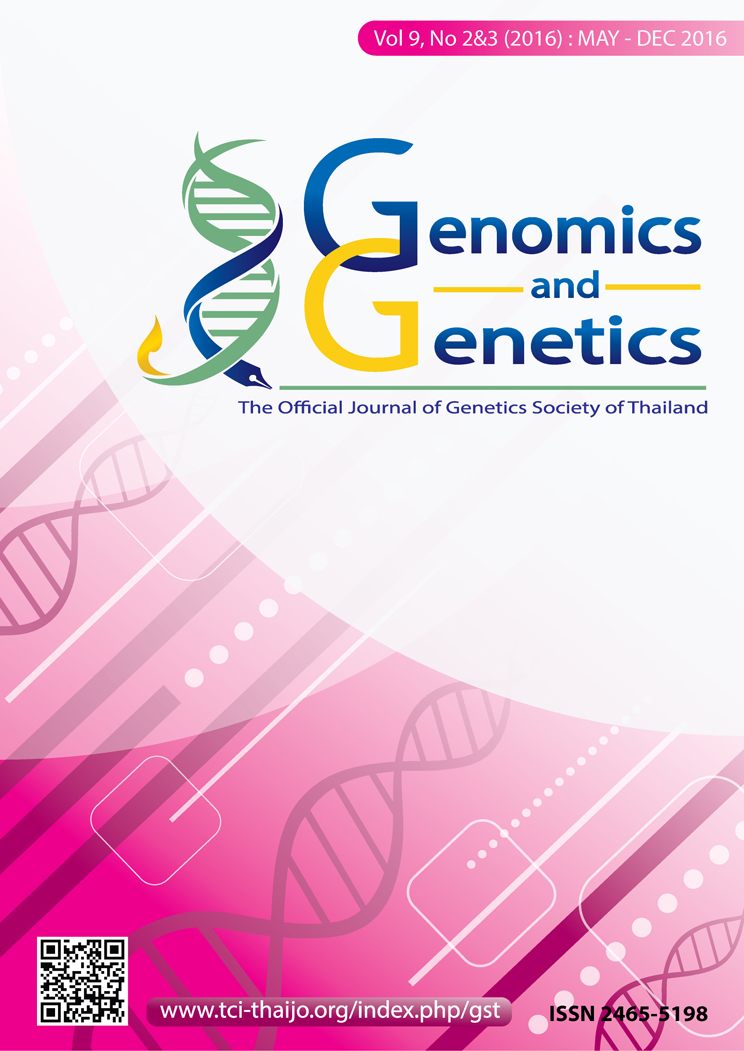Sex steroids regulate genes containing intragenic LINE-1 during menstrual cycle
Keywords:
Estrogen, Progesterone, Menstrual cycle, LINE1Abstract
ABSTRACT
Long interspersed element-1 (LINE-1) are retrotransposible element. Recent studies showed that gene containing LINE-1s are regulated by epigenetic regulation of intragenic LINE-1s in cancer and in embryonic development. Moreover, intragenic LINE-1 may possess a regulatory function under physiologic condition. We hypothesized that female sex steroids could altered expressions of genes containing LINE-1. Here we analyzed the influence of intragenic LINE-1on gene expression during menstrual phases by using expression array data from public database (Gene Expression Omnibus (GEO), (http://www.ncbi.nlm.nih.gov/geo). Gene expression levels in early-, mid- and late- secretory phase were compared with those in proliferative phase. Genes containing intragenic LINE-1were highly and significantly up-regulated in early-secretory phase as compared to those in proliferative phase in both GSEs tested (GSE6364 with p< 1.05E-10; OR = 1.62; 95% CI = 1.88–1.40 and GSE4888 with p<2.22E-10; OR=1.61; 95% CI=1.87-1.39). While genes containing intragenic LINE-1 were significantly up-regulated in both mid and late-secretory phase as compared to those in proliferative phase (GSE4888 with p< 5.66E-03; OR=1.24; 95% CI = 1.44–1.06 and p<1.14E-04; OR=1.42; 95% CI=1.69-1.19. Whereas genes containing intragenic LINE-1 were found to be significantly down-regulated only in mid-secretory phase as compared to those in proliferative phase. (GSE6364 p<2.98E-02; OR=1.15; 95% CI=1.31-1.01 and GSE4888 p<6.22E-04; OR=1.25; 95% CI=1.41-1.10). Together, these data suggested that intragenic LINE-1 could play a role in regulation and expression of sex steroid regulated genes during menstrual cycle.
References
Ahmad N, and Kumar R (2011) Steroid hormone receptors in cancer development: a target for cancer therapeutics. Cancer Lett 300: 1-9.
Aporntewan C, Phokaew C, Piriyapongsa J, Ngamphiw C, Ittiwut C, Tongsima S, Mutirangura A (2011) Hypomethylation of intragenic LINE-1 represses transcription in cancer cells through AGO2. Plos One 6: 1-13.
Bakkum-Gamez JN, Laughlin SK, Jensen JR, Akogyeram CO, Pruthi S (2011) Challenges in the gynecologic care of premenopausal women with breast cancer. Mayo Clin Proc 86: 229-240.
Barrett T, Troup DB, Wilhite SE, Ledoux P, Rudnev D, Evangelista C, Kim IF, Soboleva A, Tomashevsky M, Marshall KA, et al. (2009) NCBI GEO: archive for high-throughput functional genomic data. Nucleic Acids Res 37: 885–890.
Burney RO, Talbi S, Hamilton AE, Vo KC, Nyegaard M, Nezhat CR, Lessey BA, Giudice LC (2007) Gene expression analysis of endometrium reveals progesterone resistance and candidate susceptibility genes in women with endometriosis. Endocrinology 148: 3814-3826.
Chen Z, Kang X, Wang L, Dong H, Wang C, Xiong Z, Zhao W, Jia C, Lin J, Zhang W, et al. (2015) Rictor/mTORC2 in oocytes regulates folliculogenesis and its inactivation causes premature ovarian failure. J Biol Chem 290: 6387-6396 .
Edwards GM, Wilford FH, Liu X, Hennighausen L, Djiane J Streuli CH (1997) Regulation of Mammary Differentiation by Extracellular Matrix Involves Protein-tyrosine. J Biol Chem 273: 9495–9500.
Edgar R, Domrachev M, Lash AE (2002) Gene Expression Omnibus: NCBI gene expression and hybridization
array data repository. Nucleic Acids Res 30: 207–210.
Feinberg AP, Tycko (2004) The history of cancer epigenetics. Nat Rev Cancer 4: 143-153.
Han JS, Szak ST, Boeke JD (2004) Transcriptional disruption by the L1 retrotransposon and implications for
mammalian transcriptomes. Nature 429: 268-274.
Lander ES, Linton LM, Birren B, Nusbaum C, Zody MC (2001) Initial sequencing and analysis of the human genome. Nature 409: 860-921.
Matlik K, Redik K, Speek M (2005) L1 antisense promoter drives tissue- specific transcription of human genes. J Biomed Biotech 2006: 1-16.
Ngamphiw C, Tongsima S, Mutirangura A (2014) Roles of intragenic and intergenic L1s in mouse and human. PloS one 8: 1-8.
Östman A, Hellberg C, Böhmer FD (2006) Protein-tyrosine phosphatases and cancer. Nat Rev Cancer 6: 307-320.
Partanen S (2001) Protein tyrosine phosphatase activity in human endometrium. Reprod Fertil Dev 13: 157-65.
Penzkofer T, Dandekar T, Zemojtel T (2005) L1Base: from functional annotation to prediction of active LINE-1 elements. Nucleic Acids Res 33: 498–500.
Senthong A, Kitkumthorn N, Rattanatanyong P, Khemapech N, Triratanachart S, Mutirangura, A (2014) Differences in LINE-1 methylation between endometriotic ovarian cyst and endometriosis-associated ovarian cancer genes associated with the cis-regulatory functions of intragenic LINE-1 elements. Int J Gynecol Cancer 24: 36-42.
Shifrin VI, Davis RJ, Neel BJ (1997) Phosphorylation of protein-tyrosine phosphatase PTP-1B on identical sites suggests activation of a common signaling pathway during mitosis and stress response in mammalian cells. J Biol Chem 272: 2957–2962
Stoker AW (2005) Protein tyrosine phosphatases and signalling. J Endocrinol 185: 19–33.
Sukapan P, Promnarate P, Avihingsanon Y, Mutirangura A, Hirankarn N (2014) Types of DNA methylation status of the interspersed repetitive sequences for LINE-1, Alu, HERV-E and HERV-K in the neutrophils from systemic lupus erythematosus patients and healthy controls. J Hum Genet 59: 178-188.
Talbi S, Hamilton AE, Vo KC, Tulac S, Overgaard MT, Dosiou C, Le Shay N, Nezhat CN, Kempson R, Lessey BA, et al. (2006) Molecular phenotyping of human endometrium distinguishes menstrual cycle phases and underlying biological processes in normo-ovulatory women. Endocrinology 147: 1097-1121.
Wanichnopparat W, Suwanwongse K, Pin-on P, Aporntewan C, Mutirangura A (2013) Genes associated with the cis-regulatory functions of intragenic LINE-1 elements. BMC Genomics 14: 1-9.
Wierman ME (2007) Sex steroid effects at target tissues: mechanisms of action. Adv Physiol Educ 31: 26-33.
Xiao-Jie L, Hui-Ying X, Qi X, Jiang X, Shi-Jie M (2016) LINE-1 in cancer, multifaceted functions and potential clinical implications. J Genet Med 18: 431–439.



